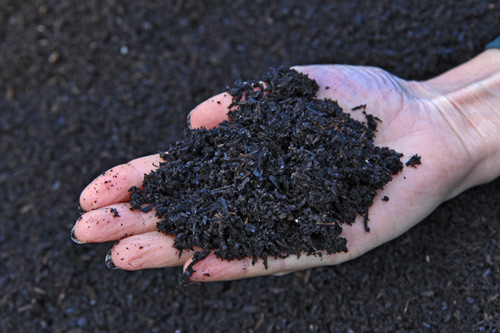The amount of carbon in the soil is a direct indication of good quality of soil. Higher carbon stocks have a direct correlation with increased agricultural yields through improved soil health. In the current scenario of climate change and global warming, much of carbon in atmosphere has to be sequestrated into soil carbon pool so that increasing CO2 in the atmosphere and resulting warming could be reduced.
The use of biochar can be a simple yet powerful tool to combat climate change by sequestering much of atmospheric carbon into soil as well as providing an opportunity for the processing of agricultural and other waste into useful clean energy.
What is Biochar?
Biochar is a solid material obtained from the carbonisation of biomass. Biochar is produced through a process known as pyrolysis, means thermal decomposition of organic material (i.e. wood chips etc, crop waste and manure) under limited supply of oxygen (O2), and at relatively low temperatures (<700°C). This process often mirrors the production of charcoal, which is perhaps the most ancient industrial technology developed by humankind. However, it distinguishes itself from charcoal and similar materials by the fact that biochar is produced with the intent to be applied to soil as a means to improve soil health, to filter and retain nutrients from percolating soil water, and to provide carbon storage. Due to the molecular structure of biochar, it is in a more stable form than the original carbon (i.e. plant biomass, manure, etc.) both chemically and biologically. As a result, it is more difficult to breakdown biochar in the soil, resulting in a product that can remain stable in the soil for hundreds to thousands of years.
One of the great things about producing biochar through the process of pyrolysis is the fact that the main by-product is a gas, known as syngas which is a form of bio energy waiting to be used. It is easily captured and can be used to produce heat and power, to generate electricity as well as power the pyrolysis machine in the process, making the machine largely self sufficient.
Application in Agriculture
The potential benefits that biochar offers for farming includes:
- Improved soil fertility and crop yields
- Increased fertilizer use efficiency
- Improved water retention, aeration and soil tilth
- Higher cation exchange capacity and less nutrient runoff
- Clean and efficient biomass energy production from crop residues and forest debris
- Combined heat, power, and refrigeration opportunities from pyrolysis
- Leads to net sequestration of carbon from the atmosphere to the soil thereby increasing soil organic carbon (SOC)
- Greater on-farm profitability
- Can be financed through carbon markets and carbon offsets
- Decreased nitrous oxide and methane emissions from soils
- Provides powerful tool for reversing desertification
- Provides alternative for slash-and burn agriculture
- Can work as component of reforestation and afforestation efforts
- Can produce electricity, bio-oils, and/or hydrogen fuels
- Can use wide variety of feedstock including crop residues such as wheat and corn straw, poultry litter, cow manure, forest debris, and other farm-based biomass resources
- Acts as a liming agent to reduce acidity of soils
- Carbon sequestration by the natural process of photosynthesis
- Net production of energy in form of bio energy
Environmental Impact of Biochar
Biochar can be a simple yet powerful tool to combat climate change. Biochar sequestration is considered carbon negative as it results in a net decrease in atmospheric carbon dioxide over centuries or millennia time scales. It can make a big difference in the fossil fuel emissions worldwide and act as a major player in the global carbon market with its robust, clean and simple production technology. As organic materials decay, greenhouse gases, such as carbon dioxide and methane (which is 21 times more potent as a greenhouse gas than CO2), are released into the atmosphere. Instead of allowing the organic matter to decompose and emit CO2, pyrolysis can be used to sequester the carbon and remove circulating CO2 from the atmosphere and store it in virtually permanent soil carbon pools, making it a carbon-negative process. By charring the organic material, much of the carbon becomes “fixed” into a more stable form, and when the resulting biochar is applied to soils, the carbon is effectively sequestered. It is estimated that use of this method to “tie up” carbon has the potential to reduce current global carbon emissions by as much as 10 percent.
The use of pyrolysis also provides an opportunity for the processing of agricultural residues, wood wastes and municipal solid waste into useful clean energy. Although some organic matter is necessary for agricultural soil to maintain its productivity, much of the agricultural waste can be turned directly into biochar, bio-oil, and syngas.
Biochar can also provide an extremely powerful means of reversing desertification. In most semi-arid and desert climates the soil is nearly void of soil organic carbon (SOC), and thus has the potential to absorb massive quantities of carbon. Generally, the amount of carbon in the soil is a direct indication of soil quality: the greater the amount of SOC, the higher quality the soil. Higher carbon stocks have a direct correlation with increased agricultural yields, higher plant moisture absorption, improved soil tilth, and higher levels of soil biological activity.
Conclusion
Biochar has a both positive as well as negative impact on crop growth, yield and human health. This technology involves a large biomass demand for production as well as fine biochar particles are causing severe health hazards thus, it is critical that we address this issue with caution. However, application of biochar to damaged soils of low fertility seems promising and has a high potential for mitigating climate change and helping to raise soil fertility but not a silver bullet to improve nutrient economy in farming, or to increase crop yields. We need to investigate and utilise it to reduce our emissions and sustain soils, but we cannot rely on it for solving our emerging problems.
